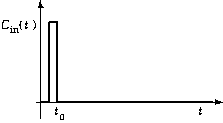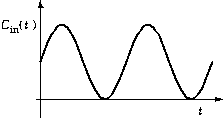


Cin(t ) can be approximated in a number of ways, using a variety of models depending on the situation being modeled. In this module, we will only consider three scenarios:
| Cin(t ) is an impulse function. This means that we imagine a sudden spike of input, as shown in the graph to the right. After this spike, concentration in the inflow returns to zero. So at the time we start watching, the inflow is pure but the lake contains a pollutant. | 
|
| Cin(t ) is an step function. This means that the concentration of contaminant in the inflow has just increased when we start watching the lake, so it carries more contaminant into the lake. We see why such a function is called a step function in the graph to the right. | 
|
| Cin(t ) is an sinusoidal function. This means that the inflow concentration varies regularly (as given by a sin function) with respect to time. Such a function is shown to the right. | 
|